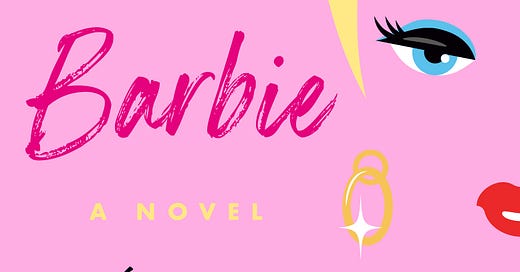Friends & Fiction’s own Ron Block recently sat down with USA Today bestselling author Renée Rosen to discuss her new novel Let’s Call Her Barbie. This book is a work of historical fiction based on Ruth Handler, the real-life mastermind of the iconic Barbie doll. Kirkus describes the novel as “a fictional retelling of Barbie’s origin story, from Ruth’s first brainstorm until she leaves Mattel in the 1970s…infused with pathos and wit.” Called “a fresh and fun take on Barbie lore…clever and satisfying,” by #1 New York Times bestselling author Shelby Van Pelt (Remarkably Bright Creatures), this book was just published on January 21st by Berkley and includes a reader’s guide and exclusive vintage Barbie photos. We are delighted to introduce you to Renée and Let’s Call Her Barbie!
This book is a fascinating and very adult account of how Barbie came to be, telling the stories of the people who made her a global phenomenon. Beyond their stories, and in true Friends & Fiction style, what is Let's Call Her Barbie really about?
Great question! Let’s say you take Barbie out of the equation; what we have is a rags-to-riches story and a business caper all rolled into one. It’s a story of resilience, innovation and how these people bounced back from disappointments, upsets and near failure as they struggle to bring their dream to fruition. The novel explores teamwork, creative differences, dueling egos, and the many peaks and valleys that come with massive success.
Where did the original idea for this story spark for you, and did the recent blockbuster Barbie film have any influence on your work?
Believe it or not, I had the idea for this novel long before the Barbie movie came out. In 2019, I was on a panel about feminism with a woman who worked in the doll division at Mattel. She told me the story of Ruth Handler, and I got goosebumps. I knew right then and there that I would write a novel about the creation of Barbie, but at the time, I had two other books (The Social Graces and Fifth Avenue Glamour Girl) already in the pipeline.
I remember being almost finished with the first draft when the Barbie hype was ramping up to full force. I admit there were many bouts of FOMO along the way. I tried to write as fast as I could, but at the end of the day, it was more important to get the story right rather than to chase the moment. That said, the Barbie movie definitely impacted our marketing efforts. We made a conscious choice to “lean into” the Barbie mania in terms of the title, the pink cover, and how we positioned the book in the marketplace.
In retrospect, I think this book is dropping at the perfect time. I think the movie and those scenes with Rhea Perlman portraying Ruth Handler sparked a lot of curiosity about who created Barbie.
Give us an overview of Ruth Handler. Reading her story brought to life all the obstacles those ambitious women of her time faced, including the constant uphill battles she had to overcome just by being a woman. Tell us about writing this force of nature.
Ruth was a fascinating and very complicated woman. She was petite but had a giant-size personality. She was a risk-taker, swore like a sailor, chain-smoked, and refused to let anyone or anything get in her way. The Mattel employees called her “Ruthless” for a reason. She went toe to toe with all the men at Mattel and always got her way.
The greatest challenge in capturing Ruth was finding out what made her tick and what made her so tough and driven. I think the answer can be found in the estranged relationship she had with her mother, coupled with the role model she discovered in her older sister. Her mother and sister both had their hand in shaping the woman who would defy all odds in the business world, especially within the toy industry. And yet, despite that brash exterior, Ruth was vulnerable when it came to her daughter and her need to prove her worth to the world. She had some soft, tender spots deep inside that I wanted to reveal.
One of the most compelling characters in the book is Stevie. Where did she develop from, and did you always know she would be such an important voice in telling this story?
Stevie is a work of pure fiction, and I brought her into the story for various reasons. A key reason was to show the immense impact that Barbie had on a young fashion designer’s career. She also represented the women’s movement, which was beginning to galvanize during Barbie’s infancy. I also wanted to give the reader a glimpse of Mattel from a perspective that wasn’t part of the company’s ownership or management. Lastly, I felt it was important to illustrate the spell that Jack Ryan, Barbie’s head engineer and designer, could have over women. Ruth and Charlotte would never have succumbed to his charms, but a young designer like Stevie very well could have.
The research for Let’s Call Her Barbie must have been intense, from learning about the real people involved, getting the time periods beautifully accurate, and the changing of society during the times you write about. What was your process, and was there anything that truly surprised you along the way?
I always start by reading whatever non-fiction, memoirs, and related material I can get my hands on. I also watched a lot of documentaries, including Tiny Shoulders and Barbie. I found it very helpful to speak with various Barbie collectors and Barbie experts, most of whom I met while attending the annual Barbie convention.
In terms of surprises, there were far too many to mention here, but I can say that I was floored when I discovered that Barbie was based on a German prostitute gag doll for men! What came as no surprise at all was the criticism of Barbie’s body, however, readers will discover that Barbie’s body was driven by her wardrobe rather than some misogynistic fantasy. Finding out that Barbie and Ken were brother and sister in real life was also unexpected and quite disturbing to me, as well as to the siblings.
Speaking of research, a great deal of time had to go into learning about the wardrobes and accessories, and the design and creation of the doll itself. Were you able to speak with or learn from designers?
I really hit the research jackpot when I met Carol Spencer, one of the original Barbie designers. Carol went to work at Mattel in 1963 and was 90 when we went to lunch. (She’s 94 now and still going strong). She is considered Mattel royalty and wrote the definitive book on Barbie’s iconic wardrobe, entitled Dressing Barbie.
Carol shared her journey with Barbie and told me stories about working with Ruth Handler and Jack Ryan. She described so many details about their personalities and helped me capture the free-loving, fun, laid-back culture inside Mattel in those early years. Having that opportunity with Carol was truly a gift from the writing gods. There are details within the book that I would never have found in any other secondary sources.
The women’s movement of the 60’s and 70’s really affected your characters and even Barbie herself. Can you talk about the importance of revisiting those days?
I don’t think it’s possible to really tell the story of Barbie and her lasting appeal without looking at the other side of the equation. From the very beginning, many mothers objected to Barbie because of her adult body. In the years following Barbie’s introduction, the National Organization for Women, and Women’s Liberation Movement also took issue with Barbie. They were especially outspoken when Mattel released Growing Up Skipper in 1975. She was billed as two-dolls-in-one because she sprouted breasts when you cranked her arm. That enraged the Women’s Movement, and if they’d been critical of Barbie and her other doll friends before, now they blamed Mattel for causing eating disorders and mocked Barbie’s pink plastic material world and bubble gum brains. They had completely lost sight of the fact that Barbie was created as a means to empower young girls to be anything they could imagine. Somehow, that message got lost in the translation. At least, it did until the Barbie movie.
The popularity of Barbie has seen its ups and downs but has endured and even become more popular than ever in current times. Why do you think the doll endures?
There’s no doubt that Barbie is evergreen, but that being said, I think the Barbie movie really gave her image a boost. Today Barbie is cool and while some still might not like her, many people have changed their views about her and what she’s come to represent. Ruth would have been very happy about that.
Perhaps one reason why Barbie has endured is because of the universal truth that little children long to be older children. There’s a reason they play with their mother’s makeup and put on their high-heeled shoes. Barbie has tapped into that bit of magic from the very beginning. Also, she can still unlock a child’s imagination in a way that other toys can’t. Take for example, video games. They allow a child to interact within a set framework designed for them and controlled by the game’s creator. Barbie was open to anything a child could dream up. I think that’s why she’s still around.
What are the main things you would like readers to take away from reading your book and do you have your own history and relationship with Barbie?
I’m certain that Barbie is one of the reasons why I became a writer. Growing up, I never went anywhere without my Barbies, and I conjured up very elaborate storylines. Since the book came out, I have been delighted to hear from readers who tell me that Let’s Call Her Barbie brought back so many wonderful childhood memories. If my novel can do that for people and provide a much-needed escape from today’s harsh realities, I couldn’t ask for more.
Congratulations on this success. Let’s Call Her Barbie is a terrific, nostalgic, eye-opening, and fun book. What is next for you?
Putting Barbie out in the world and letting go of this book was harder for me than it’s been with my previous novels. But I am finally in the very early stages of my next novel. I have fragments and my characters are just beginning to speak to me (which I know might sound crazy to some.) I wish I could say more, but the story is just too raw at this point to share any details for fear of jinxing myself. I don’t know about other authors, but I get very superstitious when it comes to starting something new. It’s so delicate and feels so fragile in my mind.
About the Author
Renee Rosen is a USA Today bestselling author. Her novels include Fifth Avenue Glamour Girl, The Social Graces, Park Avenue Summer, Windy City Blues, White Collar Girl, What the Lady Wants and Dollface as well as the young adult novel, Every Crooked Pot. She is a native of Akron, Ohio, and a graduate of American University in Washington, D.C. She now lives in Chicago and is at work on a new novel. Renee frequently visits book clubs (either in person or via Zoom) and is available for speaking engagements.
About the Book
She was only eleven-and-a-half inches tall, but she would change the world. Barbie is born in this bold novel by USA Today bestselling author Renée Rosen.
As featured in The New York Post ∙ Book Riot ∙ The Nerd Daily ∙ Chicago Review of Books ∙ and more!
“A fresh and fun take on Barbie lore…clever and satisfying.” – Shelby Van Pelt, #1 New York Times bestselling author of Remarkably Bright Creatures
When Ruth Handler walks into the boardroom of the toy company she co-founded and pitches her idea for a doll unlike any other, she knows what she’s setting in motion. It might just take the world a moment to catch up.
In 1956, the only dolls on the market for little girls let them pretend to be mothers. Ruth’s vision for a doll shaped like a grown woman and outfitted in an enviable wardrobe will let them dream they can be anything.
As Ruth assembles her team of creative rebels—head engineer Jack Ryan who hides his deepest secrets behind his genius and designers Charlotte Johnson and Stevie Klein, whose hopes and dreams rest on the success of Barbie’s fashion—she knows they’re working against a ticking clock to get this wild idea off the ground.
In the decades to come—through soaring heights and devastating personal lows, public scandals and private tensions— each of them will have to decide how tightly to hold on to their creation. Because Barbie has never been just a doll—she’s a legacy.
Includes a Reader’s Guide and Exclusive Vintage Barbie Photos!
Stay in Touch!
Subscribe to our PODCAST.
Join our FACEBOOK group.
Follow us on INSTAGRAM.
Subscribe to our YOUTUBE channel.
Find details about everything F&F on our WEBSITE.
Shop our guests’ & hosts’ books in our shop on BOOKSHOP.
Join the F&F Official BOOK CLUB with Brenda & Lisa.
Upgrade to our PAID Subscription for bonus content from our hosts and guests.









Reading now and loving ❤️!
One of the best book interviews I’ve read…. Great revelations about back story and book itself!